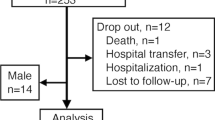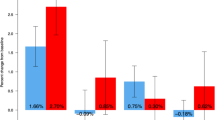Abstract
This study investigated the effect of different severities of CKD on femoral neck bone mineral density (BMD) in patients treated with denosumab. This study was a retrospective case review of CKD patients treated with denosumab. Baseline age, sex, and body mass index (BMI) were recorded for all patients. All comorbidities such as diabetes, hypertension, liver, and estimated glomerular filtration rate (eGFR) serum collagen type 1 cross-linked C-telopeptide (CTX) were also recorded. All subjects underwent dual energy X-ray absorptiometry assay of the femoral neck to determine the BMD. Changes in femoral neck BMD between baseline and 1 year after denosumab administration were recorded. A total 108 patients with CKD who had received denosumab therapy were enrolled. The mean age was 71.04 ± 9.64 years, and 96 patients (88.9 %) were women. Baseline eGFR correlated negatively with changes in the BMD of femoral neck (Rho =40.6, P < 0.01). The lower the eGFR, the more was the improvement in BMD in the femoral neck after denosumab therapy. When changes in femoral neck BMD were assessed as outcome measures using linear regression, young patients (P = 0.001) and those with a low eGFR benefitted more from denosumab therapy (P = 0.029). Denosumab therapy is effective in cases of low eGFR and young age. Aggressive medical attention is needed in these patients.

Similar content being viewed by others
References
Malluche HH, Monier-Faugere MC (2006) Renal osteodystrophy: what’s in a name? Presentation of a clinically useful new model to interpret bone histologic findings. Clin Nephrol 65(4):235–242
Moe S, Drueke T, Cunningham J et al (2006) Definition, evaluation, and classification of renal osteodystrophy: a position statement from Kidney Disease: Improving Global Outcomes (KDIGO). Kidney Int 69(11):1945–1953
Yenchek RH, Ix JH, Shlipak MG et al (2012) Bone mineral density and fracture risk in older individuals with CKD. Clinical journal of the American Society of Nephrology: CJASN 7(7):1130–1136
Alem AM, Sherrard DJ, Gillen DL et al (2000) Increased risk of hip fracture among patients with end-stage renal disease. Kidney Int 58(1):396–399
Boyle WJ, Simonet WS, Lacey DL (2003) Osteoclast differentiation and activation. Nature 423(6937):337–342
Kostenuik PJ, Nguyen HQ, McCabe J et al (2009) Denosumab, a fully human monoclonal antibody to RANKL, inhibits bone resorption and increases BMD in knock-in mice that express chimeric (murine/human) RANKL. Journal of bone and mineral research : the official journal of the American Society for Bone and Mineral Research 24(2):182–195
Delmas PD (2008) Clinical potential of RANKL inhibition for the management of postmenopausal osteoporosis and other metabolic bone diseases. Journal of clinical densitometry: the official journal of the International Society for Clinical Densitometry 11(2):325–338
Bone HG, Bolognese MA, Yuen CK et al (2008) Effects of denosumab on bone mineral density and bone turnover in postmenopausal women. J Clin Endocrinol Metab 93(6):2149–2157
McClung MR, Lewiecki EM, Cohen SB et al (2006) Denosumab in postmenopausal women with low bone mineral density. N Engl J Med 354(8):821–831
Matsuo S, Imai E, Horio M et al (2009) Revised equations for estimated GFR from serum creatinine in Japan. American journal of kidney diseases: the official journal of the National Kidney Foundation. 53(6):982–992
Pagani F, Bonetti G, Stefini F, Panteghini M (2000) Evaluation of a fully automated assay to measure C-telopeptide of type I collagen in serum. Clin Chem Lab Med 38(11):1111–1113
Hsu CC, Hwang SJ, Wen CP et al (2006) High prevalence and low awareness of CKD in Taiwan: a study on the relationship between serum creatinine and awareness from a nationally representative survey. American journal of kidney diseases: the official journal of the National Kidney Foundation. 48(5):727–738
Chen YR, Yang Y, Wang SC et al (2014) Multidisciplinary care improves clinical outcome and reduces medical costs for pre-end-stage renal disease in Taiwan. Nephrology (Carlton) 19(11):699–707
Ott SM (2013) Therapy for patients with CKD and low bone mineral density. Nat Rev Nephrol 9(11):681–692
Gordon PL, Frassetto LA (2010) Management of osteoporosis in CKD Stages 3 to 5. American journal of kidney diseases: the official journal of the National Kidney Foundation. 55(5):941–956
Bone HG, Bolognese MA, Yuen CK et al (2011) Effects of denosumab treatment and discontinuation on bone mineral density and bone turnover markers in postmenopausal women with low bone mass. J Clin Endocrinol Metab 96(4):972–980
Jamal SA, Ljunggren O, Stehman-Breen C et al (2011) Effects of denosumab on fracture and bone mineral density by level of kidney function. J Bone Miner Res Off J Am Soc Bone Miner Res 26(8):1829–1835
Block GA, Bone HG, Fang L, Lee E, Padhi D (2012) A single-dose study of denosumab in patients with various degrees of renal impairment. J Bone Miner Res Off J Am Soc Bone Miner Res 27(7):1471–1479
Qu X, Huang X, Jin F et al (2013) Bone mineral density and all-cause, cardiovascular and stroke mortality: a meta-analysis of prospective cohort studies. Int J Cardiol 166(2):385–393
Suzuki T, Yoshida H (2010) Low bone mineral density at femoral neck is a predictor of increased mortality in elderly Japanese women. Osteoporosis international: a journal established as result of cooperation between the European Foundation for Osteoporosis and the National Osteoporosis Foundation of the USA 21(1):71–79
Dooley AC, Weiss NS, Kestenbaum B (2008) Increased risk of hip fracture among men with CKD. American journal of kidney diseases: the official journal of the National Kidney Foundation 51(1):38–44
Hruska KA, Teitelbaum SL (1995) Renal osteodystrophy. N Engl J Med 333:166–174
Acknowledgments
Authors’ contributions
BCC designed and performed the research;
YCC analyzed the data and wrote the final article.
Author information
Authors and Affiliations
Corresponding author
Ethics declarations
Disclosures
None.
Rights and permissions
About this article
Cite this article
Cheng, BC., Chen, YC. Young patients and those with a low eGFR benefitted more from denosumab therapy in femoral neck bone mineral density. Clin Rheumatol 36, 929–932 (2017). https://doi.org/10.1007/s10067-016-3447-y
Received:
Revised:
Accepted:
Published:
Issue Date:
DOI: https://doi.org/10.1007/s10067-016-3447-y




